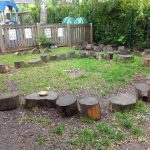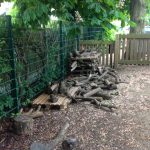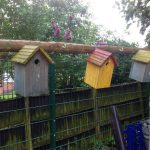
July 4, 2017, by Rupert Knight
Outdoor learning: a waste of space?
In today’s climate there has been much discussion and debate regarding the lack of physical exercise that children do and the increase of passive watching of screens. Some parents have also denied children the freedom of outdoor play due to fears relating to traffic, ‘stranger-danger’ and the lack of natural spaces. Therefore the school outdoor environment becomes even more important in helping deliver a ‘broad and balanced’ curriculum. However, environments are often not being utilised as the pressures of the curriculum can lead schools to focus more on academic achievement and therefore to stay inside a ‘structured’ classroom rather than seeing the opportunities of regular outdoor learning. In this post Esther Fulton considers the benefits of outdoor learning and looks at one school’s approach.
Uses of outdoor space
The outside environment is commonly used within schools for break times, when play occurs without any imposed structure. The importance of play is at the core of a child’s development. By playing, children understand the importance of learning to cooperate, develop relationships and understand the world they live in as well as learning to explore, discover, fail and succeed. Read Ken Robinson’s response to this.
As well as this, the school grounds can provide natural learning environments for children that are not all ‘play-based’. The curriculum can be set in another context and allow for more creativity to take place outside the classroom as well as inside.

Throughout the history of education the importance of outdoor learning has been highlighted. Froebel (1837) introduced the concept of the ‘kindergarten’ with the knowledge that outside space was needed for all children to develop as they benefited from the wider community which included nature. More recently the idea of Forest Schools in England was set up in 1995 with the support of the Forest Education Initiative based on the Scandinavian approach of giving children the experience of gaining contact with nature from an early age.
Forest Schools were set up with a constructivist and social constructivist approach to learning where children would be involved in experimentation and problem solving. This approach was linked to the theorists Piaget and Vygotsky. Piaget saw children as ‘constructing’ knowledge from direct experience of the world around them and Vygotsky saw the importance of others in the process of constructing meaning by creating a zone of proximal development to build on their existing knowledge base (Knight, 2016). Children actively make meaning when engaged with mistakes and problems and therefore the teaching methods are often child-led. Forest Schools can also provide teachers with appropriate assessment of their pupils through observation and of how children are expressing themselves physically and verbally.
Adapting Forest School
The original introduction of Forest Schools led to many schools creating links with their local woodlands and using these off-site spaces to enhance the curriculum. However, Forest Schools do not have to involve costly and time-consuming trips away from the school setting. Some schools have turned part of their outdoor space into smaller ‘outdoor learning’ environments where all year groups can gain easy access. For example, one of the schools in the University of Nottingham partnership has converted their unused space into a Forest School garden for all pupils to enjoy.
Here, Nicki Pursglove of Banks Road Infant School in Nottingham highlights the benefits and impact the Forest School garden has had.
_______________
‘‘An area of ‘no-man’s’ land on the school grounds was converted into a Forest School garden with the help of funding from the school PTA. It is now used throughout the school where all children can access natural resources and take part in environmental activities. The children are also involved in their local community and use the local shop to practise using money and take recycled packaging to the local supermarket.
The main impact the garden has had is that teachers have got to know the ‘whole child’ and are not just focused on their academic success. It has given children the opportunity to shine, who wouldn’t necessarily shine in the classroom…….particularly lower attaining boys as it has given them the opportunity to succeed and they are often the leaders with their creative ideas when approaching a Forest School activity. It has highlighted their ability to focus their attention, where within the classroom they may not have been able to. It has also been good for pupils who are able academically but were afraid to take risks or take on a challenge. It has benefited the children with special educational needs, as the calm environment of being surrounded by nature helps them approach their sensory learning in a different way.
Whereas before, we would have provided ‘safe’ lessons in the classroom, now by using the outdoor environment it has helped the children to take risks, tackle problems with groups of children and allowed the teachers to not necessarily get involved and provide the answers for them. This has led to teachers standing back from the ‘indoor learning’ too and letting the children tackle problems on their own and perhaps fail, which teachers wouldn’t have allowed to happen previously.
The next steps for the use of the outdoor environment is to take it into other areas of the curriculum so that they are not just stand alone lessons and instead to access this environment for all our lessons.’’
_______________

The benefits of outdoor learning
Much research has been done around the benefits of learning outside, be it within the Forest School setting or just outside in the school grounds. Not all schools have extensive grounds to utilise but even small spaces can be beneficial to bring learning alive and allow exploration and creativity to take place. From this research it is clear that the main outcomes from working in the outdoors are developing the ‘whole child’ in areas such as self-confidence, social skills, motivation and concentration alongside the improvement in language and communication skills. Often children that struggle more within the confines of the classroom blossom in the outdoor space where they may feel less restricted and more independent in their learning and discovering. It is a chance to observe the whole child in a different context and it gives the children the opportunity to offer ideas and questions spontaneously rather than always responding to adult questions.
‘The rigidity of classroom roles and norms of behaviour sometimes appear to be dissolved in participatory pedagogy outdoors, characterized by more open relationships and mutually constructed ways of thinking about, rather than delivering, knowledge’ (Waite, 2010)
Therefore, working with children outside the classroom can allow teachers to view their pupils with a different perspective. Their roles can shift and differences between pupils that may have arisen in the classroom can be dissipated whilst outside. Pupils often see adults having fun and appearing more relaxed in their teaching which then has an impact on how children view their learning. Barriers to learning need to be dissolved and all children allowed to experience a different learning context.

The government have seen the importance of including outdoor learning and how it has an impact on a child’s development. The Learning outside the Classroom Manifesto was launched after consultation in 2006 stating that ‘every child and young person should experience the world beyond the classroom as an essential part of their learning and development, whatever their age, ability or circumstances’. Alongside this Ofsted stated in 2008 that ‘learning outside the classroom contributed significantly to raising standards and improving pupils’ personal, social and emotional development’.
Children need space to learn and do certain things on a bigger scale. The outdoors gives them the space to be noisy, messy, to run, jump, climb and move in different ways. It is the opportunity to engage with their senses and embrace the different outside elements throughout the whole year, not just when the sun is shining! This may then lead to children wanting to spend more time outside when they are out of school too which could help to tackle some of the obesity problems Britain is encountering. However, outdoor provision should not be seen as just for physical development but for other learning opportunities that are not necessarily separate from indoor learning. Neither should it just be used as a reward for when indoor work has been completed. Instead it should be viewed as a way of embedding learning in a real context whilst allowing learners to choose, create, change and be in charge of their environment.
‘Teaching children outside a classroom, almost regardless of what we are teaching, increases the vitality of learning’ (Sedgwick, 2012, p.3)
Therefore, outdoor areas are not ‘a waste of space’ if they are used appropriately to enable learners to access a ‘broad and balanced curriculum’.
To help the busy life of the teacher here are some links to websites that have ideas and resources for all schools to use:
- Transforming Outdoor Learning in School
- Wildtime Learning
- Woodland Trust
- Nottingham City Forest Schools
Some questions to ponder:
- How does your school utilise the outdoor space?
- What areas of the curriculum lend themselves to working outdoors?
- Are there unused spaces within the school grounds that could be converted to outdoor learning areas?
- How can your teaching enable pupils to take more risks and tackle problem solving?
We’d love to hear your views and experiences.
References:
Knight, S. (2016) Forest School in Practice: For All Ages. Sage.
O’Brien, L. (2009) Learning outdoors: the Forest School approach. Education 3–13, 37(1), pp.45-60.
Sedgwick, F. (2012) Learning outside the Primary Classroom. Oxon:Routledge.
Waite, S. (2010) Losing our way? The downward path for outdoor learning for children aged 2–11 years. Journal of Adventure Education & Outdoor Learning, 10(2), pp.111-126.

nice blog for out door learning
After an outdoor learning session at University and reading the blog it has reminded me to make better use of the outdoor space at my school. I’m going to check out the covered areas for reading or other activities and try to do an angles maths lesson outside before half term.
It his made me want to ask my school how they use their outside space, especially being an inner city school. It would be useful to know what spaces I can use to incorporate the curriculum with outside learning.
Especially with the the weather getting nicer, I’m looking forward to see if I can do different things with the outside during Placement B, that I otherwise wouldn’t have really thought about doing.
There is now so much evidence that simply being outdoors in a natural environment is a huge aid to reducing anxiety and increasing a sense of well-being in learners that surely this alone is justification for taking learning into the outdoors whenever practical and possible.